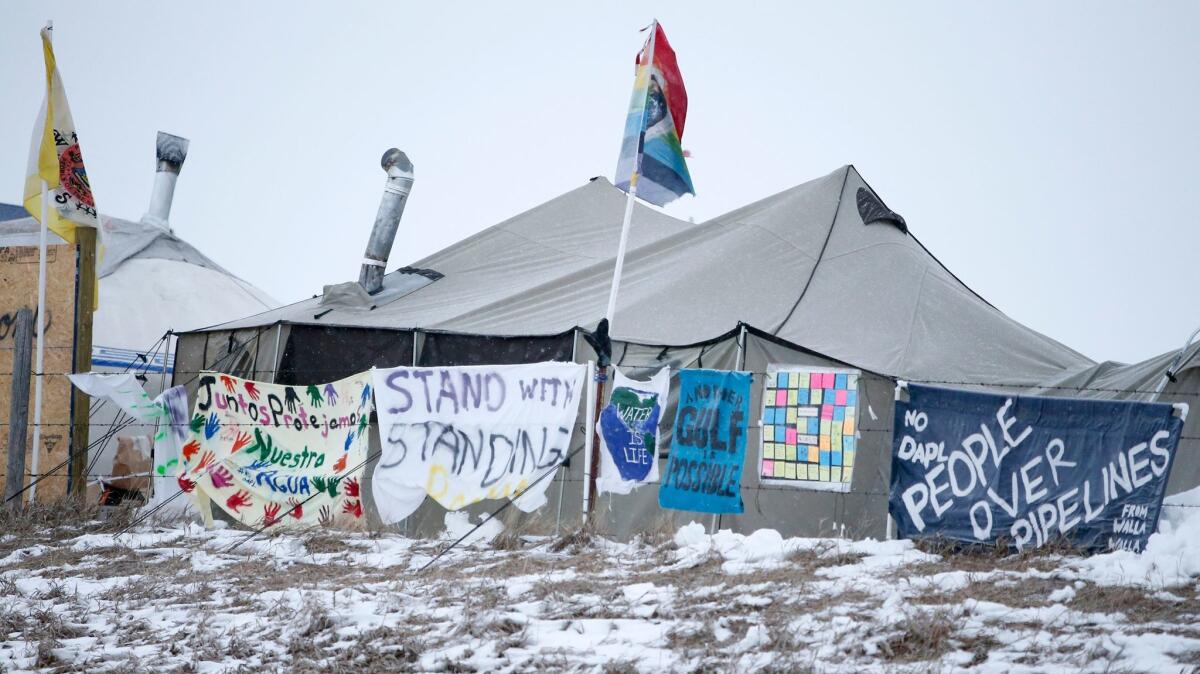At Standing Rock, a vow to stay and fight — though protesters face pressure on many fronts to leave for good

- Share via
Reporting from Along the Cannonball River, N.D. — Many protesters here knew they could be celebrating a short-lived victory when the Obama administration announced last month that it would not issue a final permit to build the Dakota Access pipeline until it conducted a more extensive environmental review.
Now, after President Trump told his new administration to look for a way to issue the permit, their worries appear to have been well founded.
“Oh, I think that pipeline’s going to get built,” said Benji Buffalo, who has camped here since last fall. “Trump said so, and he’s the law of the land now, right?”
Not that everyone here, including Buffalo, is giving up.
Although the protest camps have shrunk this winter, many of the few hundred people who remain have vowed to stay and fight.
The U.S. Army Corps of Engineers, the agency overseeing the pipeline’s construction in the area, has yet to take any public action on Trump’s instructions. A spokesman for the agency said Friday that it was proceeding with the expanded environmental review.
If the new administration stops that review, the Standing Rock Sioux Tribe, which has argued that the project threatens its water supply and sacred sites, has promised to fight in court.
But the stability and power of the camps are being tested — and Trump’s actions are just one reason why.
After spending much of last year encouraging others to join them in protest, the Standing Rock Sioux Tribe is now urging protesters at the largest camps to leave by the end of this month “for liability reasons and [due to] social and financial strain.”
Many members of the tribe have grown weary of outside protesters using reservation bathrooms and showers. They worry that the largest camp has become littered with abandoned property and garbage, and they are frustrated that law enforcement, blaming the protests, has closed the main road heading north to Bismarck, the area’s largest city.
“We understand and acknowledge the power of the camps in bringing us this far in our fight against the Dakota Access Pipeline,” the tribal council wrote on Thursday in a message on Facebook. “We maintain, however, that given current conditions, both physical and political, the focus must shift from maintaining camps to being at the political and legal forefront.”
The council warned that the Trump administration “will not respond to the camps with moderate actions” and said the tribe did not want to put its citizens in danger or jeopardize its success in fighting the pipeline.
The statement followed a lengthy meeting the previous night between tribal officials, including Chairman David Archambault II, and North Dakota’s new Republican governor, Doug Burgum, at the reservation’s Prairie Knights Casino.
For many in the tribe it was noteworthy that Burgum, unlike his predecessor, Jack Dalrymple, visited the reservation while the protests are underway.
Burgum, a North Dakota native who made a fortune selling his company, Great Plains Software, to Microsoft more than a decade ago, supports the pipeline. But he has expressed a desire to “understand each tribe’s individual issues and circumstances so that we may move forward together toward greater mutual respect, harmony and prosperity,” as he put it in his first State of the State speech this month.
Among the topics discussed at the Wednesday meeting were clearing the camps and opening the road, which Burgum signaled could happen. The council issued its statement about the camps the next day, saying it needed “to focus our energy on the intense government-to-government political situation and not the camps.”
The governor, the council and meteorologists have also emphasized a threat that has nothing to do with politics: springtime floods that could start as early as March.
The first protest camp here was established last spring on a bluff high above the confluence of the Missouri and Cannonball rivers. Over the summer, hundreds more people from across the country formed other camps in the closest unoccupied land they could find — the low flats near where the rivers meet.
At first, the protesters pitched tents and teepees, but as the weather grew colder, some set up sprawling military-style barracks, wood-framed structures and prefabricated shelters and solar panels.
The reason the land was unoccupied, however, is that it is a floodplain.
“They should all be worried about it,” said Allen Schlag, a hydrologist with National Weather Service in Bismarck. “It’s a legitimate risk. I would say there’s about a 50-50 chance that where the campsite is will have water on it by the spring. There’s greater risk this year than there is in a normal year. They simply have more water on the ground.”
In recent weeks, some protesters have left, but others have moved their sites to higher ground, saying they have already endured the brutal summer heat, clashes with law enforcement and winter conditions that have taken temperatures well below zero on some nights and coated the horizon in snow and ice.
In its statement Thursday, the tribal council said it would not attempt to forcibly remove any protesters, though it warned that law enforcement might.
“Please do not return,” the council wrote, “but instead put your heart and effort into supporting the battle for clean water from your various homes around the globe.”
That same day, 29-year-old Damian Archambault, a distant relative of the tribal chairman, said he and many others knew about the request but did not plan to heed it.
“Even with that deadline, we’re still going to stay,” he said. “We really feel that we should stay.”
More to Read
Sign up for Essential California
The most important California stories and recommendations in your inbox every morning.
You may occasionally receive promotional content from the Los Angeles Times.













